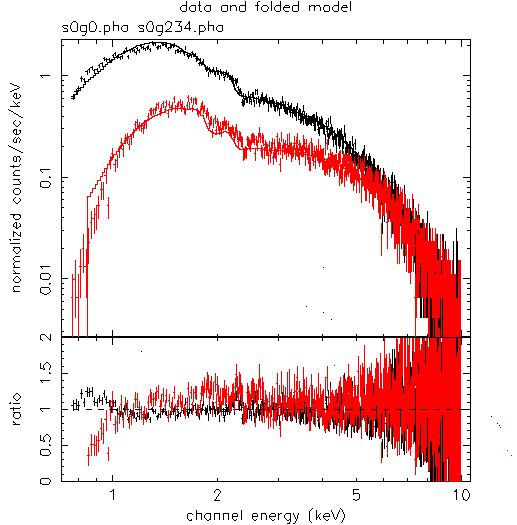Event Threshold and 2-Pixel Events
We have become aware of shortcomings of the SIS response generator, sisrmg with regard to its treatment of the event threshold for 2-pixel events.
1. Event grades and event threshold
SIS events are detected, classified, and put in telemetry using the following algorithm:
- Search for a pixel whose PHA value exceeds the event threshold, and is the highest in a 3x3 area centered on it.
- Search for any neigboring pixels that have PHA values greater than the split threshold. Single pixel events have a grade value of 0; two-pixel events have a grade value of 2, 3 or 4; if any of the diagonal neigbors have a PHA exceeding the split threshold, then such a event will have other grades, usually to be discarded.
- Optionally, if the PHA value of the central pixel is less than the lower level discriminator, then such an event will not be put in the telemetry (if level discrimination is on).
On the ground, additional processing may be performed: DFE and RDD correction both change the PHA values; PHA to PI conversion is a function of time, and position on the chips. Therefore, the event threshold is no longer sharp in PI spectra.
Ignoring for the moment the blurring of the event threshold, it is straightforward to model how raising the event threshold will change the calibration of grade 0 (single pixel) events: all events with PHA values below the event threshold are eliminated, and nothing changes above the event threshold.
It's not so trivial for 2-pixel (grades 234) events. It's clear that, no events with total PHAs which are grater than twice the event threshold will be eliminated (since, by definition, the central pixel must have a PHA at least as great as the event threshold). Events whose total PHA values are barely greater than the event threshold are likely to be eliminated, unless the charge split is extreme. One needs to know the distribution of the ratio of charges in the two neighboring pixels. Current version (FTOOLS v4.1 and earlier) has a rather simplified model of this effect, and therefore predicts errorneous efficiency for grade 234 events, when the event treshold is significantly greater than ~0.4 keV.
2. Examples of the effect (i)
The first example is the SIS-0 data from sequence 30002000, a PV phase 1-CCD mode observation (the source is a CV with a complex spectrum, but this is believed to have a negligible effect).

The above plot shows the SIS-0 Bright2 mode grade 0 vs grades 234 spectra, extracted from unaltered data (event threshold=100). It can be seen that the relative calibration of 1 pixel vs 2 pixel events is reasonably good (this is a part of the grade branching ratio calibration).

In this version, we show the same comparison for a data which has been specially processed to simulate the effect of a 0.7 keV event threshold. The relative calibration is no longer acceptable. The grade 234 spectrum has a spurious excess Nh of 2.96e21 (the plot is with no excess Nh). The fit to the g0234 spectrum results in a slight excess of Nh (of the orde 2e20). A different comparison (not shown) demonstrates the sharp cut-off for g0 data, and a gradual cut-off for g234 data, of the 0.7 keV event threshold.
3. Examples of the effect (ii)
The second example is the SIS-0 data from sequence 54016000, a 4-CCD mode observation in 1996 Apr of a serendipitous, bright, point source. The data have been RDD and DFE corrected, although the RDD effect may not have been completely eliminated.

The above figure shows the effect of real event threshold. The model is with the best-fit g0 Nh of 4.3e21; best-fit g234 Nh is 6.4e21.

This is a comparison of SIS-0 g0 spectrum with GIS-3 spectrum. The model is with the best-fit GIS-3 Nh of 3.6e21. The response has a sharp edge at the event threshold; the rounding effect of RDD correction plus PHA-PI correction is seen in the data.
4. Summary
We find that the current (relatively simple-minded) calibration of how 2-pixel events interact with the event threshold may cause an apparent excess in Nh. This effect is more important for RDD-affected data because a higher fraction the X-rays are detected as 2-pixel events. By extracting g0 and g234 spectra separately, the importance of this effect can be estimated; the effect can be minimized by relying on the g0 spectrum at low energies.
This file was last modified on Friday, 22-Jun-2001 15:59:29 EDT
Curator:
HEASARC Guest Observer Facility
If you have any questions concerning ASCA, visit our Feedback form.

